Last week the first data analysis of this series got published in which I looked at the most interesting Austrian centre-backs. In this week’s analysis, the task will be to use data and statistics to find the best full-backs of Austria. The number of talented Austrian full-backs grew within the last few years and we had in this season with Stefan Lainer and Christopher Trimmel, two men who were the first-choice players in the right-back and right wing-back position respectively of their Bundesliga clubs. Due to that, the Austrian national team has now several options in these positions as we will see now.
In this data analysis, I will use data to find the best left-backs and right-backs for the national team of Austria to then look at the stats of some players in more detail. Also, I want to note that all stats which are used in this analysis are the average values per 90 minutes.
Comparison
Before we look at the results of my research which will be visualised in graphs, I have to make clear which filters I used. My central filters were that the players would need to be Austrians and that they have played in this season at least 1013 minutes as a full-back or a wing-back for their respective club. Next, I deleted all players who play in Austria’s second division and are not U23 players. I did that since full-backs who are 23-years-old or even older and still don’t play in Austria’s top-flight or a different league of Europe are neither interesting for Austria’s head coach Franco Foda at the moment, nor will the players have a realistic chance to get nominated for the national team within the upcoming months and years.
Also not included in the following graphs are the men who have dual citizenship and could play for the senior team of Austria, but already made appearances for the youth teams of other nations. Considering these aspects, we’ll get in the following the current best full-backs of Austria and young players who could be nominated for the national team of Austria within the next years.
The first metrics at which we look will be the defensive ones. Even though the full-backs are in Foda’s 4-2-3-1 are incredibly important for the build-up and the attacks, they are still part of the back four and therefore should have decent defensive abilities. The statistics at which we look at first will be the successful defensive actions per game and the success rate for defensive duels in %. This data should help us to find the Austrian full-backs with the best defensive abilities.
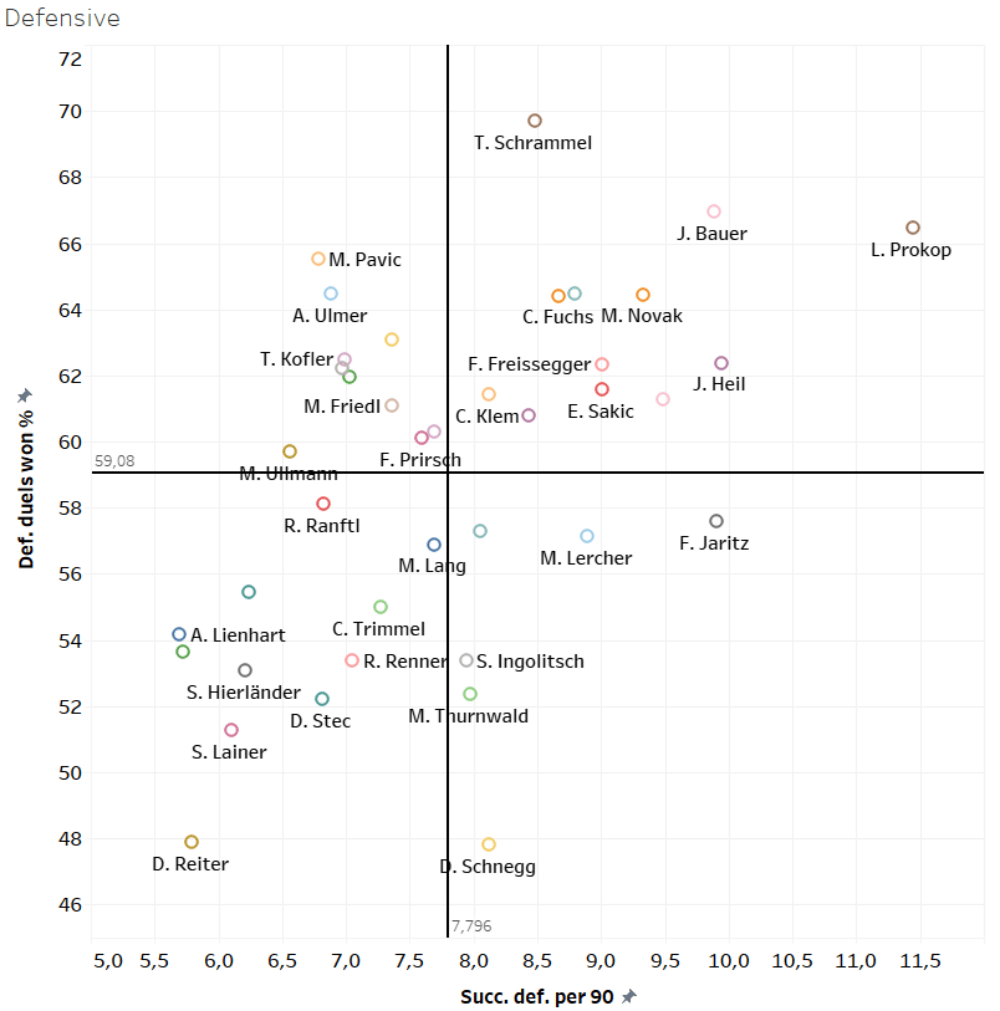
The player who stands out in the graph above is Lukas Prokop of Austria Vienna II who is 20 years old and is the younger brother of Dominik Prokop (a promising winger of Austria Vienna who we’ll probably talk about in another data analysis of this series). Prokop is a left-back and has really great defensive values as he makes 11.44 successful defensive actions per 90 minutes and wins 66.47% of his defensive duels. Even though you have to consider that he plays in Austria’s second division, they are still solid values for a player at his age. The 32-year-old Thomas Schrammel has the best value for winning defensive duels (69.7%). Jürgen Bauer who was featured in every game of Horn this season as part of the starting XI wins 66.95% of his defensive duels which is the second-highest value.
As I already mentioned earlier in this data analysis, the full-backs need to be quite strong when it comes to offensive actions due to the tactics of Foda. In his 4-2-3-1, it is mostly Bayern Munich’s David Alaba and Valentino Lazaro who are the wingers, and these two don’t permanently stay wide as they often drift into position in the half-spaces. Due to this, the full-backs need to push forward to position higher up the pitch and provide width. To see how offensively strong the players are, we take their statistics for progressive runs and progressive passes (both per 90 minutes).
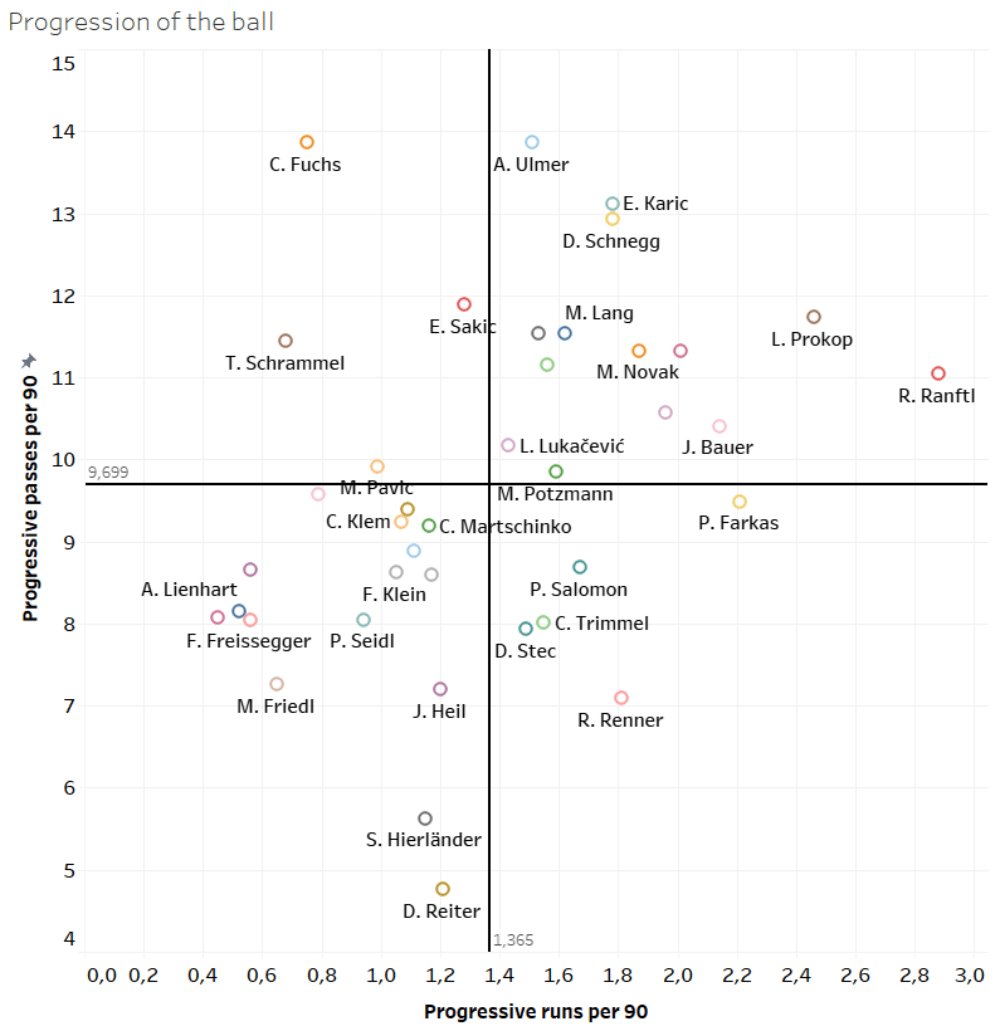
Again, Prokop of Austria Vienna II is among the very best players when it comes to these statistics as he is solid for both actions with 11.74 progressive passes and 2.46 progressive runs per game. Christian Fuchs (who is at Leicester City as the backup of Ben Chilwell) has together with RB Salzburg’s Andreas Ulmer, the highest number of progressive passes with 13.87 (both have the exact same value). However, as Fuchs already retired from the national team of Austria, we won’t look at his statistics in detail. Reinhold Ranftl, who plays at LASK Linz as a right wing-back in their 3-4-3 system, has the highest value for progressive runs as he makes on average 2.88 per 90 minutes.
Now we have looked at the defensive and offensive statistics of the defender. Before we look at a few interesting players in more detail, I visualised data in one more graph as it is also important to see how active a player is not just when it comes to the progression of the ball, but also in the final third. Therefore, the metrics in the following graph will be crosses and expected assists.
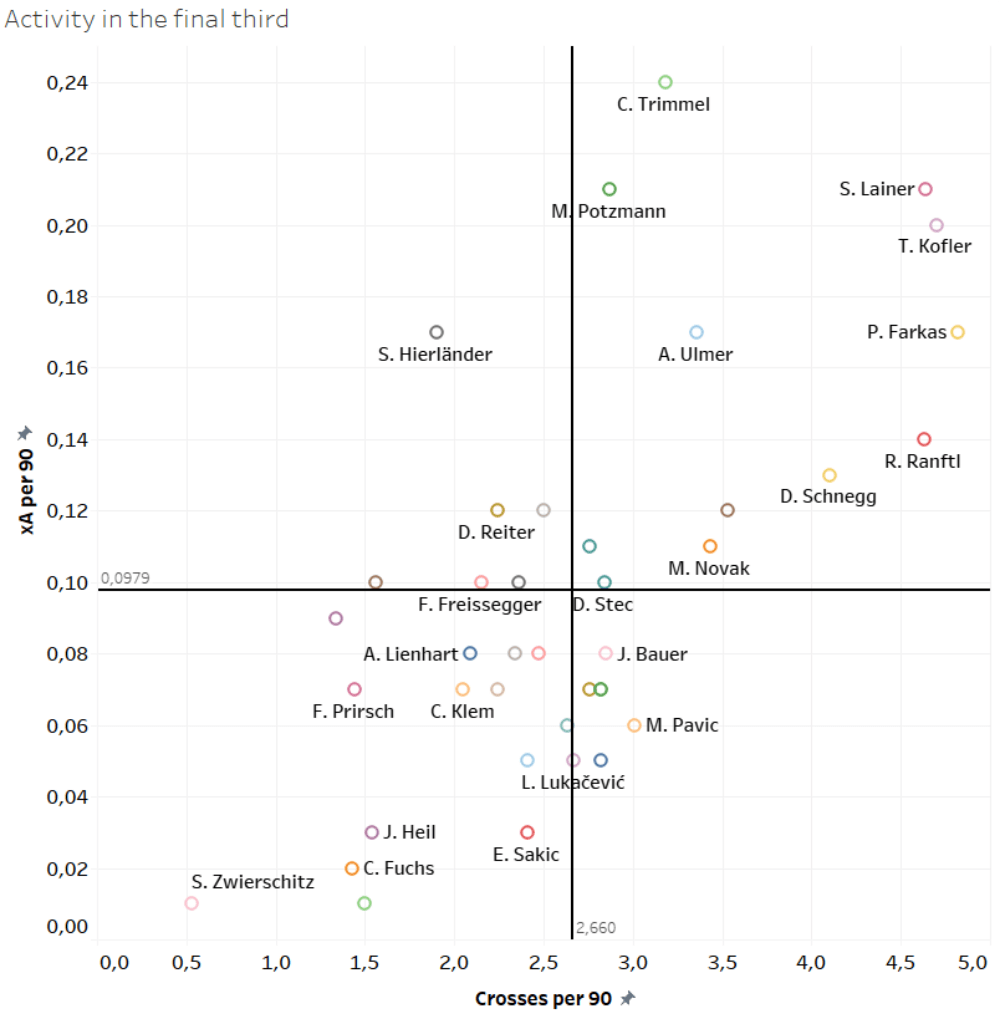
For people who regularly watch the Bundesliga, it’s not such a huge surprise that the two already mentioned Trimmel and Lainer are among the very best players when it comes to these two values, especially Lainer, who is an incredible player with his aggression and will to push forward. RB Salzburg’s right-back and right wing-back respectively Patrick Farkas is the one with the most attempted crosses (4.82), while Trimmel is the Austrian full-back with the best xA value with 0.24.
As the next step, we’ll take a closer look at five players who are according to the data the most interesting full-backs of Austria.
Christopher Trimmel, right-back, 33 years old, Union Berlin
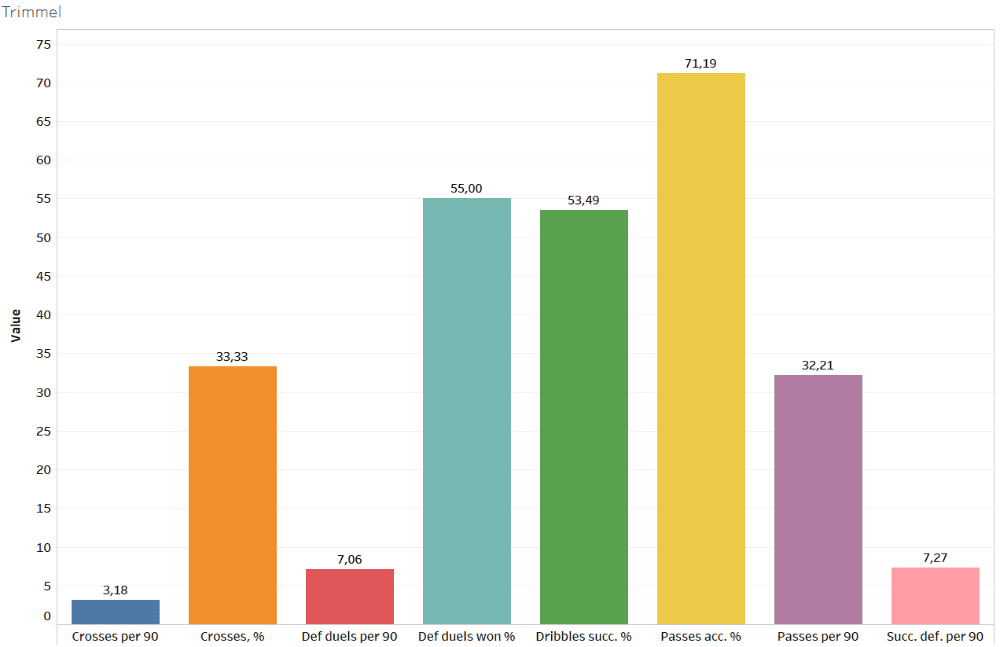
That the 33-year-old full-back who plays at Union Berlin mostly as a wing-back would be one of the five players at which we take a closer look is clearly no surprise as he stood out in two out of the three graphs above. In the graph for the defensive abilities he was indeed not that good, but you still always have to consider in which league the players perform regularly.
And the fact that Trimmel is among the full-backs of Austria with the best statistics, even though he plays for Union Berlin in the Bundesliga already tells us that he has great qualities. He is involved in 7.06 defensive duels per game what tells us that he doesn’t hesitate to look for the duel, but the success rate (55%) compared to the other full-backs is quite low. Also, as we already saw earlier in this data analysis, his statistics for xA (0.24) and crosses (3.18) are astonishing. Considering this, when looking at Austria’s full-backs with the highest activity in the final third, he’s clearly among them.
Even though Trimmel is physically really strong, I expect that the Euros 2021 will be his last major tournament for the national team as he is currently a regular part of it.
Stefan Lainer, right-back, 27 years old, Gladbach
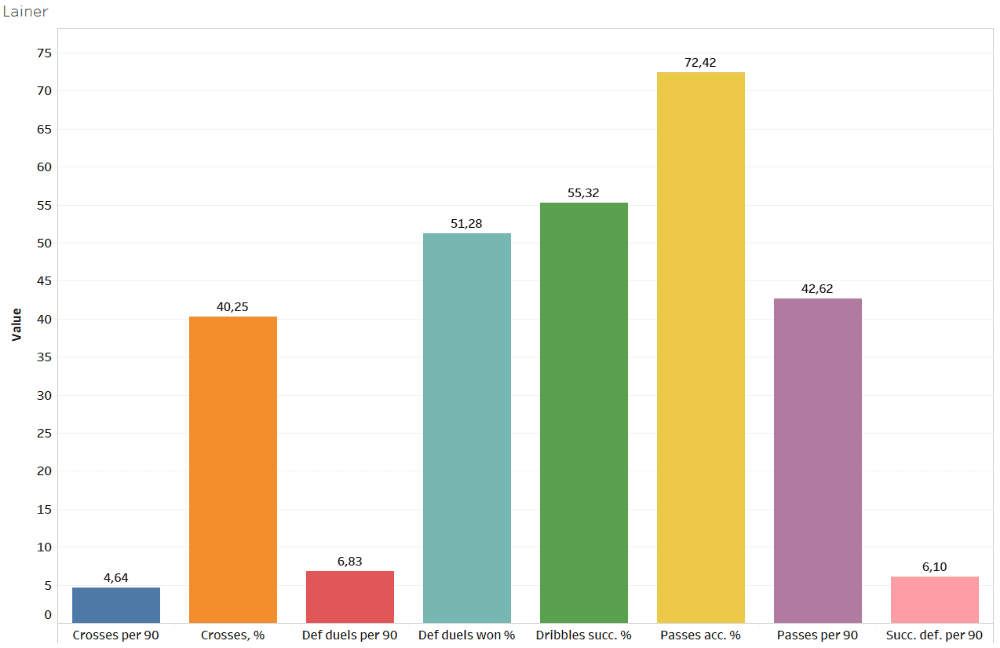
Without any doubt, the 27-year-old right-back of Gladbach is the best Austrian full-back at the moment for the majority of football fans. He already convinced most people back then during his time at RB Salzburg, but now in the Bundesliga on a bigger stage, he continues to show decent performances. Especially his will (and stamina) to run the right wing up and down for 90 minutes fascinates football fans and somewhat resembles Liverpool‘s Andy Robertson.
Besides, Lainer is also a full-back who permanently tries to bring the ball into the penalty box and delivers on average 4.64 crosses per 90 minutes with an accuracy of 40.25%. Both values are in each statistic among the very best of all Austrian full-backs in this data analysis.
However, according to the statistics, Gladbach’s right-back needs to work on his defensive abilities as he wins just 51.28% of his defensive duels which is the third-lowest value of all Austrian full-backs in this data analysis, and additionally, he just makes 6.1 successful defensive actions per 90 minutes – the fourth-lowest value. It’s worth noting once more that you always have to consider the league in which the players are playing at, and both Lainer and Trimmer are in one of Europe’s best leagues.
Patrick Farkas, right-back, 27 years old, RB Salzburg
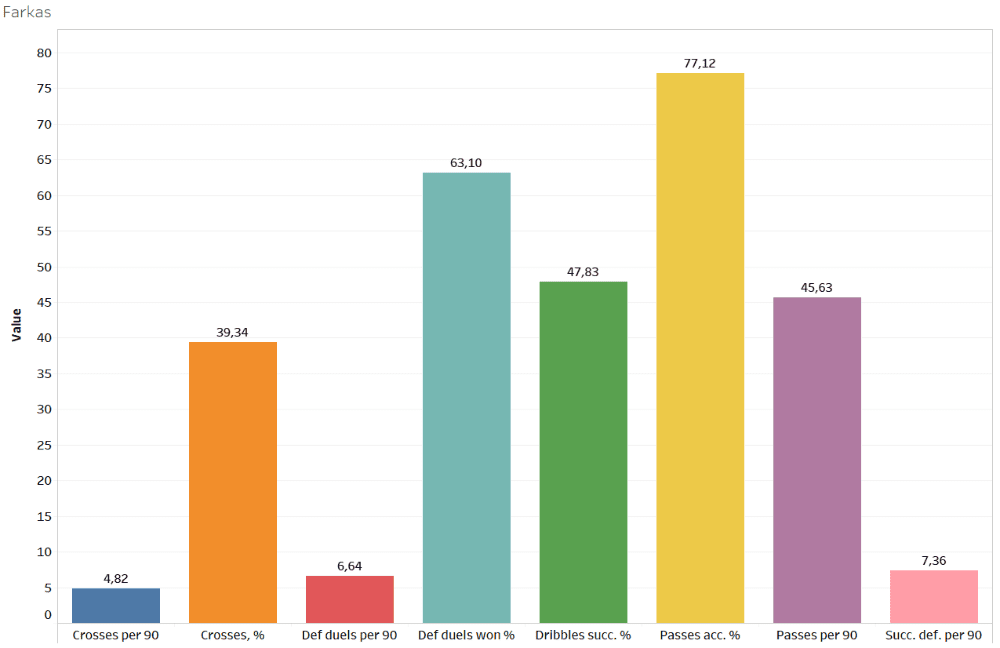
The 27-year-old defender of RB Salzburg will be the third and last right-back before we will go on to have a detailed look at two left-backs. Even though it’s questionable how many minutes on the field Farkas would have collected in this season if Rasmus Kristensen didn’t get injured, he is among my top five full-backs because he seems to have no real weakness according to the statistics. He wins 63.1% of his defensive duels and is quite active in the final third as he delivers 4.82 crosses per game.
Furthermore, he makes 9.49 progressive passes per game (slightly lower than the average) and 2.21 progressive runs which is one of the best values in this data analysis. In addition, 77.12% of his passes find a teammate which is a decent value. The main reason for these stats is that he had a stroke back in October and had to pause for a few months. In the games after his return, you clearly saw that he was a bit more careful on the pitch, choosing mainly to pass, and that he would need more time to get back on his old level.
Sill, before his injury, the 27-year-old right-back showed decent performances and often impressed with his active and offensive-orientated style of play. Due to that, he perfectly fits into the tactics of RB Salzburg and it would be no surprise if he would also fit well in Foda’s system but he has made until now only appearances for the youth teams of Austria and hasn’t debuted yet for the senior team.
Andreas Ulmer, left-back, 34 years old, RB Salzburg
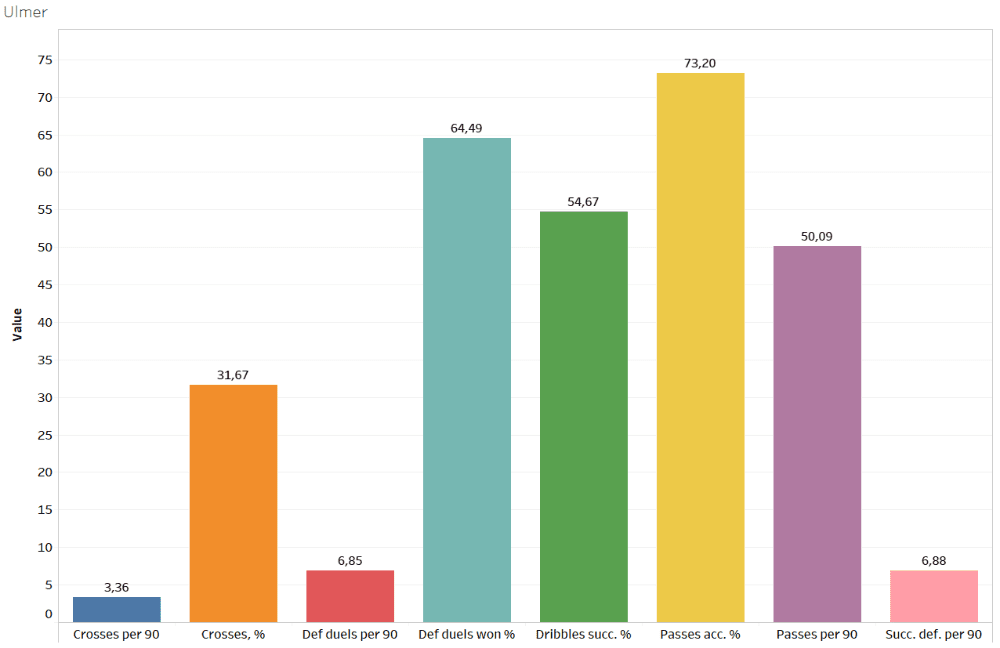
RB Salzburg’s captain will be one of the two left-backs on whom we will have a closer look and is also currently the first-choice left-back of Foda. That’s not such a huge surprise when we consider that he harmonises perfectly with Alaba on the left-wing since Bayern Munich’s player often shifts in while Ulmer provides the width while he’s positioned in a higher line.
He wins 64.49% of his defensive duels which is a great value while he makes just 6.88 successful defensive actions per 90 minutes. In this case, you have to consider that RB Salzburg are among the most dominant teams in the Austrian Bundesliga and due to that Ulmer doesn’t need to win defensive duels or intercept passes that often. That’s also the explanation for the low value of Farkas (7.36) in that statistic.
Even though Ulmer is strong on the ball and 54.67% of his dribbles are successful, he is an even better passer of the ball and so it’s no surprise that he has together with Fuchs the highest value for progressive passes (13.87). We have a similar situation compared to Trimmel as Ulmer is already 34-years-old and even though he’s currently Foda’s favourite left-back, it’s questionable how long he can compete on his current high level.
Lukas Prokop, left-back, 20 years old, Austria Vienna II
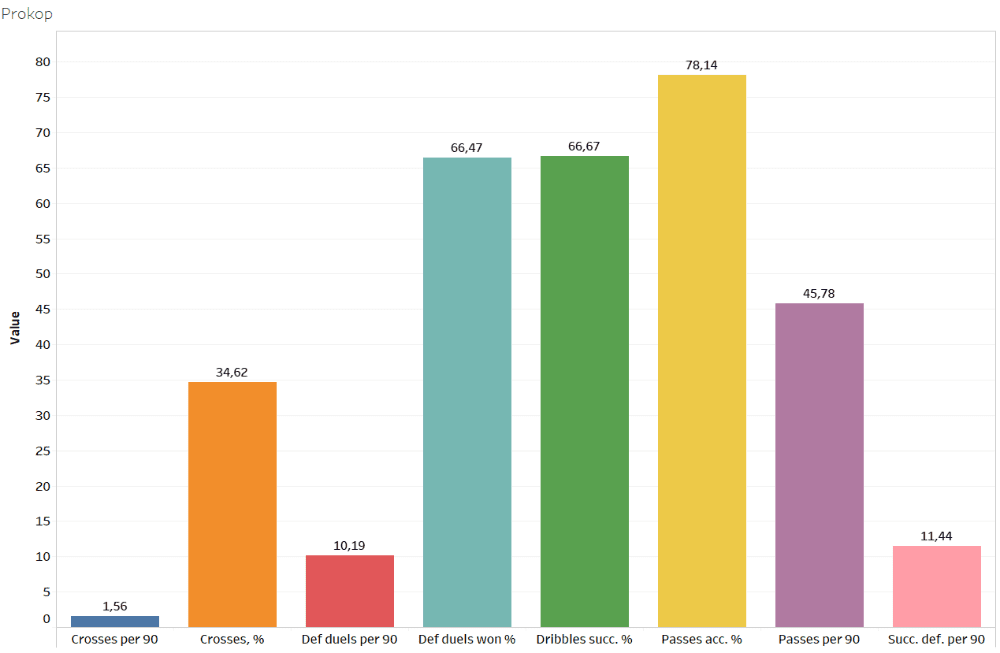
While we had until now three full-backs who are at the moment regular part of Austria’s national team (Trimmel, Lainer, and Ulmer) and with Farkas we have one who will probably soon debut for the senior team; Prokop is the one for the future. Even though he’s just 20 years old, he has already great statistics and is a regular starter for Austria Vienna II. Of course, you need to consider that he is still playing in Austria’s second division, but still, his metrics are decent.
He wins 66.47% of his defensive duels and makes on average 11.44 successful defensive actions per game. Furthermore, he has a great success rate for dribbles with 66.67% and his passing accuracy is also decent with 78.14%. The main reason for his low value of crosses (1.56) is that they are not a central part of the tactics of Austria Vienna II as they mainly try to get through the centre in the final third.
All in all, it seems as Prokop would have no real weakness while his strengths are his defensive abilities according to the statistics. If he gets the chance to prove himself in the first team of Austria Vienna and gain some experience in the Austrian Bundesliga, we’ll probably see him sooner than later in the national team.
Conclusion
While Austria has several decent centre-backs and right-backs, their main problem in the defence could be the left-back position as I’m not sure for how many more years Ulmer can play on his current level. Prokop could be the solution but that depends on his development and if he is ready to take the next steps for the next time.
Meanwhile, they have in the right-back position with Trimmel (33), Lainer (27), Farkas (27), and Ranftl (28), four players who are all on a pretty high level and all of them, except Trimmel, are in the prime of their career. Next week, the defensive midfielders of Austria will be the topic of the next data analysis.





Comments